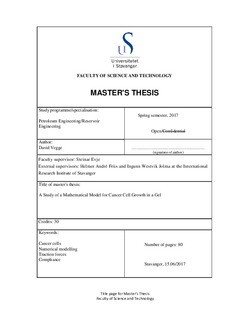| dc.description.abstract | In this thesis, a mathematical model describing gel contraction is derived and studied. The mathematical model describes the process where cells are compressing the gel, and the model is therefore used to study the cell traction forces, in for example cancer cells. In order for the cells to leave the primary tumor and invade through the tissue and extracellular matrix towards other parts of the body, they need to extract forces. These forces are studied using the mathematical model, which is derived in this thesis. The main equations used when deriving the mathematical model are the mass balance equations for the gel and cells, together with the momentum balance equation. In order to solve the mass balance equation, equations describing the force exerted by the cells on the gel and an equation describing the evolution of cell-produced chemicals are included, together with several initial and boundary conditions. The different equations needed in the numerical simulations are then converted into a new coordinate system to make the computations easier, before the equations are discretized.
The mathematical models include seven different parameters which were investigated. During the numerical simulations, the parameters were altered to see how they affected the cell traction forces. The results were that the contact inhibition parameter, bulk viscosity, proportionality constant for the chemical flux out of the gel and decay rate of the cell-produced chemicals should be high, while the isothermal compressibility, the parameter describing cell traction and preferred density should be low in order to obtain low cancer cell traction forces.
The numerical results were compared with experimental data. It was seen that both the numerical results from the mathematical model and the experimental results gave very similar shapes of the graphs representing gel radius over time (which is a measure of the cell traction forces), together with similar end values of the gel radius as well. It was therefore concluded that the mathematical model is representing the cell traction forces in a satisfactory manner, and can therefore be used in further investigations of cancer cell traction forces in the future.
Towards the end of the thesis, cancer metastases was investigated. It was then seen from an experimental paper that an increased stiffness of the collagen gel decreased the possibility of cancer metastases. A high stiffness corresponds to a low isothermal compressibility, which can be accomplished by for instance decreasing the temperature in the collagen gel or increasing the pressure.
The relationship between the cancer cell traction forces and metastases were also investigated, using different papers.The logical conclusion would be that an increase of the cancer cell traction forces would increase the degree of metastases, since the cell traction forces are needed in order for the cancer cells to move from the primary tumor to other parts of the body. This is also what is the most common conclusion, and what can be concluded from the results in an experimental paper. However, the results from another experimental paper give the opposite conclusion, which means that the relationship between cancer cell traction forces and cancer metastases might not be as straightforward as one might think. Future experiments should therefore be conducted on the relationship between the size of cancer cell traction forces and cancer metastases. | nb_NO |

